Preventing Overfitting: The Role of Training, Validation, and Test Sets
In machine learning, the ultimate goal is to build models that generalize well to unseen data. We don't just want a model that performs well on the data it was trained on; we want a model that can accurately predict outcomes on new, real-world data. To achieve this, we need to carefully evaluate our models and prevent overfitting, a common pitfall where the model learns the training data too well, including its noise and specific idiosyncrasies, at the expense of generalizability. The cornerstone of proper model evaluation and overfitting prevention is the strategic use of training, validation, and test sets.
1. Why Splitting Data is Essential
Imagine you're teaching a student a new concept. You wouldn't just give them practice problems and then test them on the exact same problems, would you? They might memorize the answers without truly understanding the underlying concept. Instead, you'd give them practice problems (training), check their understanding with similar but different problems (validation), and finally, test them on completely new problems (testing) to assess their true grasp of the concept.
The same principle applies to machine learning. We need to split our available data into distinct subsets to:
- Train the Model: Teach the model the underlying patterns in the data.
- Tune the Model: Optimize the model's hyperparameters (settings that control the learning process) to improve performance.
- Evaluate the Model: Assess the model's ability to generalize to unseen data, providing an unbiased estimate of its real-world performance.
2. The Three Sets: Definitions and Purposes
- Training Set:
- Purpose: This is the largest portion of the data and is used to train the machine learning model. The algorithm learns the relationships between the input features and the target variable (in supervised learning) from this data. The model's parameters (e.g., weights in a neural network, coefficients in linear regression) are adjusted during training to minimize a loss function, which quantifies the difference between the model's predictions and the actual target values.
- Typical Size: Often 60-80% of the total dataset, but this can vary depending on the size of the dataset and the complexity of the model. More data generally leads to better models, up to a point.
- Key Consideration: The training set should be representative of the overall data distribution. If the training set is biased, the model will also be biased.
- Validation Set:
- Purpose: The validation set is used to tune the model's hyperparameters and select the best-performing model configuration. Hyperparameters are settings that are not learned from the data during training (unlike the model's parameters). Examples include the learning rate in gradient descent, the number of layers in a neural network, the regularization strength, or the number of trees in a random forest. We train the model on the training set, evaluate its performance on the validation set, and adjust the hyperparameters accordingly. This process is repeated iteratively until we find the hyperparameters that yield the best performance on the validation set.
- Typical Size: Usually 10-20% of the total dataset.
- Key Consideration: The validation set must be separate from the training set to avoid overfitting to the training data. If we use the training set to both train and tune the model, we'll likely get an overly optimistic estimate of the model's performance. The validation set acts as a "practice test."
- Test Set:
- Purpose: The test set provides a final, unbiased evaluation of the model's performance on completely unseen data. After the model has been trained and its hyperparameters have been tuned using the training and validation sets, the test set is used only once to assess how well the model is expected to perform in the real world.
- Typical Size: Usually 10-20% of the total dataset.
- Key Consideration: The test set must be kept completely separate from the training and validation sets. It should never be used to influence the model's training or hyperparameter tuning in any way. It's the "final exam" and should be treated as such. Any peeking at the test set during development invalidates its purpose.
3. The Data Splitting Process
- Gather Data: Collect a sufficiently large and representative dataset.
- Shuffle Data: Randomly shuffle the data to ensure that the training, validation, and test sets are representative samples of the overall data distribution. This is crucial to avoid introducing bias. For example, if you're classifying images of cats and dogs, you don't want all the cat images in the training set and all the dog images in the test set!
- Split Data: Divide the shuffled data into the three sets (training, validation, and test). Common splits are 80/10/10, 70/15/15, or 60/20/20, but the optimal split depends on the size of your dataset and the complexity of your model.
- Train: Train your model on the training set.
- Validate: Evaluate the model's performance on the validation set and tune the hyperparameters. Repeat steps 4 and 5 until you are satisfied with the model's performance on the validation set.
- Test: Evaluate the final model's performance on the test set once. This gives you an unbiased estimate of its generalization ability.
- Never touch test data till the end: Do not use the test set performance to further adjust your model. Doing so would reintroduce bias.
4. Common Splitting Techniques
- Random Split: The simplest approach, where data points are randomly assigned to each set. This works well for large datasets with a relatively uniform distribution.
- Stratified Split: This is crucial when dealing with imbalanced datasets (where one class has significantly more samples than others). Stratified splitting ensures that the class proportions are maintained in each set (training, validation, and test). For example, if 20% of your data is labeled as "positive," a stratified split will ensure that 20% of each set (training, validation, and test) is also labeled as "positive."
- K-Fold Cross-Validation: This is a more robust technique, particularly useful when you have limited data. The data is divided into k equal-sized "folds." The model is trained on k-1 folds and validated on the remaining fold. This process is repeated k times, with each fold serving as the validation set once. The final performance is the average performance across all k folds. This provides a more reliable estimate of the model's performance than a single train/validation split. Common values for k are 5 and 10. Note that even with k-fold cross-validation, you still need a separate, held-out test set for the final evaluation.
- Time-Series Split: When working with time-series data, it's important to split the data chronologically. You train on earlier data and validate/test on later data to mimic how the model would be used in a real-world scenario. Random splitting would lead to "data leakage," where future information is used to predict the past.
5. Overfitting and Underfitting: The Importance of Validation
- Overfitting: A model that overfits performs very well on the training data but poorly on unseen data. It has essentially memorized the training data, including its noise and irrelevant details, rather than learning the underlying patterns. A large gap between training performance and validation/test performance is a strong indicator of overfitting.
- Underfitting: A model that underfits performs poorly on both the training data and unseen data. It is too simple to capture the underlying patterns in the data.
- The Validation Set's Role: The validation set helps us detect and mitigate both overfitting and underfitting. By monitoring the model's performance on the validation set during training, we can:
- Detect Overfitting: If the training performance continues to improve while the validation performance plateaus or starts to decrease, the model is likely overfitting.
- Tune Hyperparameters: We can adjust hyperparameters (e.g., regularization strength, model complexity) to reduce overfitting and improve generalization.
- Select the Best Model: We can choose the model that performs best on the validation set, as this is likely to be the model that generalizes best to unseen data.
6. Best Practices and Common Mistakes
- Never Use the Test Set for Training or Tuning: This is the cardinal rule. The test set should only be used once for the final evaluation.
- Ensure Representative Splits: Use stratified splitting for imbalanced datasets and time-series splitting for time-series data.
- Shuffle Data Before Splitting: Randomize the order of the data to avoid introducing bias.
- Use Cross-Validation When Appropriate: K-fold cross-validation provides a more robust estimate of performance, especially with limited data.
- Don't Over-Optimize on the Validation Set: While the validation set is used for tuning, be careful not to overfit to the validation set itself. This can happen if you try too many different hyperparameter combinations. This is why a separate test set is still crucial.
- Consider Data Leakage: Make sure information from the validation and test set isn't accidentially included in the training process.
7. Conclusion
The proper use of training, validation, and test sets is absolutely essential for building reliable and generalizable machine learning models. By carefully splitting the data, training the model, tuning hyperparameters using a validation set, and performing a final unbiased evaluation on a test set, we can avoid overfitting, assess model performance accurately, and build models that perform well in the real world. This process is a cornerstone of good machine learning practice and is critical for achieving trustworthy results.
Some links to check:



Comments ()